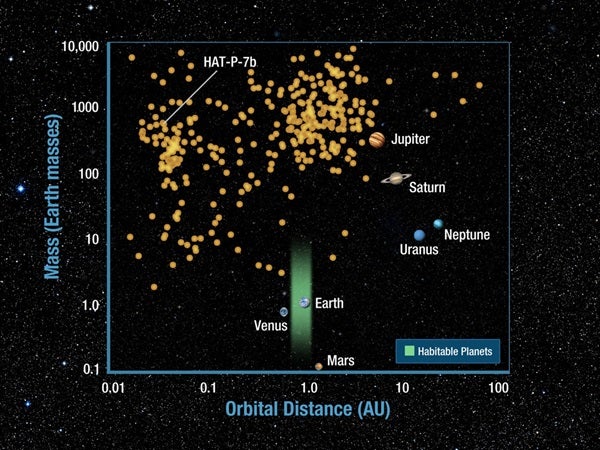NASA’s new exoplanet-hunting Kepler space telescope has detected the atmosphere of a known gas giant planet.
See our Kepler mission page for complete coverage.
The find is based on a relatively short 10 days of test data collected before the official start of science operations. Kepler was launched March 6, 2009, from Cape Canaveral Air Force Station in Florida. The observation demonstrates the high precision of the measurements made by the telescope, even before its calibration and data analysis software were finished.
“As NASA’s first exoplanets mission, Kepler has made a dramatic entrance on the planet-hunting scene,” said Jon Morse, director of the Science Mission Directorate’s Astrophysics Division at NASA headquarters in Washington. “Detecting this planet’s atmosphere in just the first 10 days of data is only a taste of things to come. The planet hunt is on!”
Kepler team members say these new data indicate the mission is capable of finding Earth-like planets, if they exist. Kepler will spend the next 3.5 years searching for planets as small as Earth, including those that orbit stars in a warm zone where there could be water. It will do this by looking for periodic dips in the brightness of stars, which occur when orbiting planets transit, or cross in front of, the stars.
“When the light curves from tens of thousands of stars were shown to the Kepler science team, everyone was awed; no one had ever seen such exquisitely detailed measurements of the light variations of so many different types of stars,” said William Borucki, the principal science investigator.
The observations were collected from a planet called HAT-P-7, known to transit a star located about 1,000 light-years from Earth. The planet orbits the star in just 2.2 days and is 26 times closer than Earth is to the Sun. Its orbit, combined with a mass somewhat larger than the planet Jupiter, classifies this planet as a “hot Jupiter.” It is so close to its star, the planet is as hot as the glowing red heating element on a stove.
The new Kepler data can be used to study this hot Jupiter in unprecedented detail. The depth of the occultation and the shape and amplitude of the light curve show the planet has an atmosphere with a day-side temperature of about 4,310° Fahrenheit (2,380° Celsius). Little of this heat is carried to the cool night side. The occultation time compared to the main transit time shows the planet has a circular orbit. The discovery of light from this planet confirms the predictions by researchers and theoretical models that the emission would be detectable by Kepler.
This new discovery also demonstrates Kepler has the precision to find Earth-size planets. The observed brightness variation is just one and a half times what is expected for a transit caused by an Earth-size planet. Although this is already the highest precision ever obtained for an observation of this star, Kepler will be even more precise after analysis software being developed for the mission is completed.
“This early result shows the Kepler detection system is performing right on the mark,” said David Koch, deputy principal investigator of NASA’s Ames Research Center at Moffett Field, California. “It bodes well for Kepler’s prospects to be able to detect Earth-size planets.”











